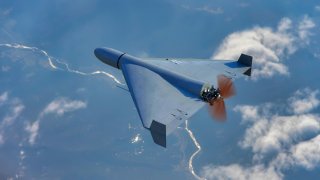When the Drone Threat Comes Home
The next war may not start with missiles or boots on the ground. It could begin with small, undetectable drones that rain destruction on America’s most vital infrastructure.
The next war may not start with missiles or boots on the ground. It could begin with small, undetectable drones that rain destruction on America’s most vital infrastructure.
In recent years, unmanned aerial vehicles (UAVs) have evolved rapidly in sophistication. But by and large, our defenses against them have not. And if the situation persists, it could lead to catastrophe.
We don’t need to look far to see how drone warfare is reshaping conflicts. On the battlefields of Ukraine, UAVs have revolutionized combat, leveled the playing field for Ukraine’s defenders, allowing Kyiv to strike back at Russian forces and the Russian homeland, and providing new intelligence-gathering capabilities. These advantages are working the other way as well, with Russian forces augmented by Iranian-origin suicide drones that have allowed Moscow to strike deep into Ukrainian territory.
The Ukraine war is a portent of things to come. Gone are the days of expensive overhead aerial reconnaissance and dangerous scouting missions. Today, small first-person drones flood the battlefield. These multi-role drones are fast, cheap, easy to train on, and extremely difficult to detect and defeat. They help with artillery targeting, conduct battle damage assessments, drop ordinance on vehicles, or be used as a weapon directly. That’s why leading technologists like former Google CEO Eric Schmidt have argued that the U.S. Army should be developing drones instead of tanks.
The problem is acute—and a distinct threat to U.S. security. Picture a group of foreign-backed terrorists deploying a swarm of explosive-laden drones over a busy U.S. airport. In mere minutes, these nearly invisible machines could destroy an airplane on the runway, claiming lives and paralyzing air travel nationwide.
Or militarily, imagine if that same team attacked an U.S. Air Force base housing air-to-air refueling planes. These flying gas tankers are strategic assets, enabling global reach for our fighters and bombers. Worse yet, as tanker modernization has fallen behind, there are fewer tankers in service with no viable backups in heavy production. A small drone attack that decimates part of our air-to-air refueling capability could halt our global air power projection and limit the reach of air assets, at least in the short term.
Such scenarios have far-reaching consequences. They require minimal cost or planning, which is precisely what would make them attractive to our enemies. Nor are they far-fetched. The technology to accomplish such disruptive missions is already here, and some of these drones can be purchased off-the-shelf from major retail chains around the nation.
Alarmingly, the growing threat these drones pose to the United States and its citizens is no longer abstract. In recent weeks, reports have surfaced about unmanned aerial vehicles flying near or around major military installations across the United States. These drones were barely noticed and evaded security at some of our most secure bases, including the home of the U.S. Air Force Air Combat Command.
That incident is part of a growing pattern. In recent years, the proliferation of drone technology has led to a sharp rise in incidents involving unmanned aerial vehicles near sensitive sites in the U.S. According to the Federal Aviation Administration's (FAA) UAS Sightings Report, more than 1,800 unauthorized drone flights were reported near airports, military bases, and critical infrastructure in 2022 alone. Even more alarming, many of these drones went undetected until they were spotted visually, highlighting the limitations of our current detection systems. With the FAA forecasting that Americans will own nearly 1.9 million drones in coming years, the need for enhanced counter-drone measures is more urgent than ever.
But if offensive drone capabilities are advancing quickly, defenses against them are not. It’s not just a lack of concrete defenses and capabilities to protect against this rapidly advancing threat. It’s the underdevelopment of processes to do so. Defeating a drone the size of a small bird is immensely difficult. Kinetically, firing weapons at such drones is nearly impossible due to their size and speed. Radar systems capable of detecting and locking on to these drones would require immense technological upgrades, training, and power. Moreover, any kinetic weapons used to counter drones could risk friendly fire or collateral damage.
Traditional defenses like electronic or GPS jamming have also proven unreliable. The latest generation of small drones is harder to detect and defeat using electronic measures, and the next evolution won’t even require communication or GPS targeting, making new lines of defense critical.
Other nations have already recognized the severity of the threat and are investing heavily in counter-drone technology. Israel, for example, has developed the “Drone Dome” system, an advanced radar and laser technology designed to detect and neutralize incoming UAVs autonomously. This system was successfully deployed in 2021 to intercept multiple drones in real-time, proving its effectiveness in high-stakes environments. Similarly, the United Kingdom is trialing a drone defense system that uses artificial intelligence to predict flight paths and disable unauthorized UAVs before they reach sensitive airspace.
These global advancements highlight the urgency for of the drone threat, and the need for the United States to catch up and prioritize counter-drone technologies as well. Our policymakers, military, law enforcement, defense industry, and think tanks must urgently develop strategies and tools to keep Americans safe—or risk disaster.
About the Author:
Darrell Owens is Senior Fellow in National Security Affairs at the American Foreign Policy Council, the former National Security Advisor to US Senator Pat Toomey (PA), and an officer in the U.S. Army Reserve.
Image: Shutterstock.


